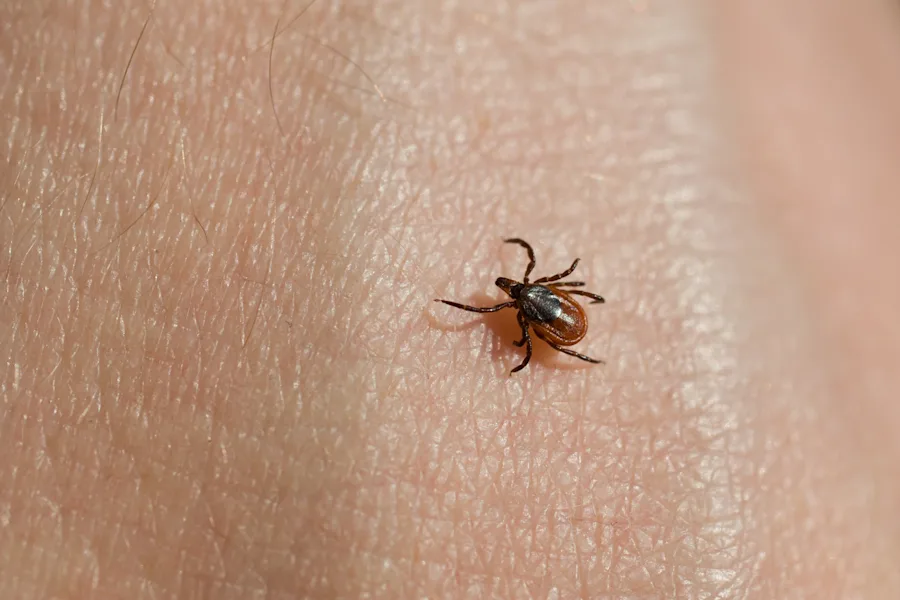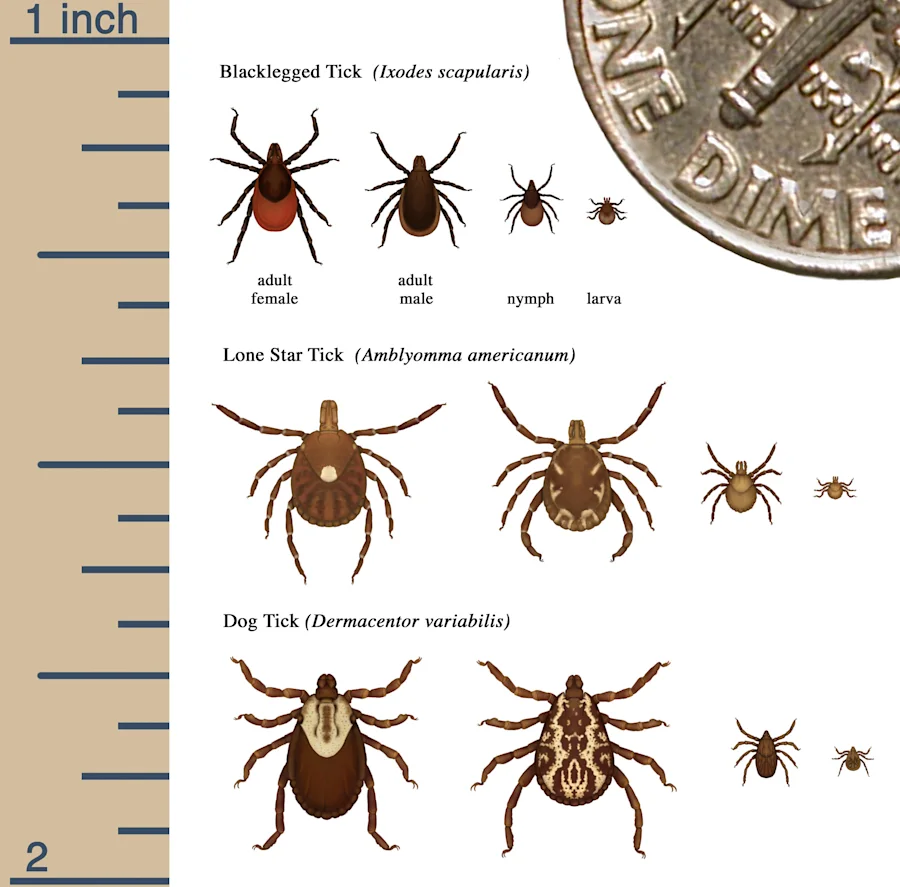What To Do If You Find A Tick (original) (raw)
What should I do if I find a tick?

Adult female black-legged ticks, like the one pictured here, can transmit the Lyme disease bacteria.
Getty Images
If you find a tick on yourself, your child, or another family member, don’t panic. A tick — or even a tick bite — doesn’t necessarily mean you are going to get Lyme disease or another tick-borne disease. However, you do need to act promptly to remove the tick. The longer a tick is attached, the more time it has to transmit the Lyme disease bacteria and pathogens that cause other disease. Let your doctor know if you are bitten by a tick so you can discuss whether you need preventive antibiotics to prevent Lyme disease.
Ticks are not like mosquitoes, which bite and then fly off. When a tick bites a person, it attaches for several days while it feeds on their blood. A tick attaches to your skin with barbed mouthparts and a cement-like substance, so that it can hold on to you while feeding.
While the tick is attached, it can transmit the bacteria that cause Lyme disease and pathogens that cause other diseases. That’s why, if you find a tick on yourself, you’ll want to remove it as quickly as possible.
You may be able to tell from looking at the tick if it is attached and whether it already bit you.
How can I tell if the tick is attached?
How can I tell if the tick already bit me?
How do I remove a tick?
If possible, before removing the tick, take a photo of it. This might help you and your doctor figure out what type of tick it is and, based on its appearance, the likelihood that it had attached to you and whether it was engorged. If you can’t get a picture, the most important step is removing the tick properly and as quickly as possible.
Attached ticks should be removed with fine-pointed tweezers, though they can also be removed with special tools.
If a tick is not yet attached but is on your skin, hair, or scalp, simply grasp it with tweezers and remove it. Try not to squeeze or crush the tick, as that can make it harder to identify. Once removed, follow steps 3 through 7 below.
To properly remove an attached tick, follow these steps:
- Using tweezers or a tick tool, grab the tick as close to your skin as possible. Try to grab the tick’s head, or directly above the head.
- Keeping the tweezers or tool firmly grasped, slowly pull the tick straight up and out to avoid breaking the tick and leaving part of it in your body. Do not twist. Also, try not to squeeze, crush, or puncture the tick, since its bodily fluids may contain infection-causing pathogens.
- Using the tweezers or tool (not your hands), place the tick inside a zippered plastic bag. It is best to kill the tick, which can be done by placing the zippered bag in the freezer or including an alcohol-based solution (such as hand sanitizer) in the bag.
- Disinfect the bite site with soap and water, or with alcohol or an antiseptic wipe.
- Wash your hands with soap and water.
- Take a photo of the tick in the bag.
- Call your doctor immediately after removing the tick.
Antibiotics to prevent Lyme disease must be given within 72 hours of removing the tick, so the sooner you tell your doctor that you’ve been bitten, the better (for more information, see Do I need preventive antibiotics for Lyme disease?).
To properly remove a tick, grasp the tick close to the skin with fine-tipped tweezers and then pull straight up and out.
Shutterstock
Thanks for your feedback!
You can remove a tick with fine-tipped tweezers, but some find it is easier to use special tools.
There are several handy tick-removal tools you can purchase like a dual-tipped tweezer such as the Bug Bite Thing Tick Remover or Tick "keys" which provide more leverage and can be kept on a keychain.
If you find a tick and don’t have one of these tools, don’t wait to go buy one. Remove the tick right away with tweezers.
What if the tick breaks apart while I am pulling it out?
If the tick breaks apart while you are pulling it out, try to pull the rest of it out with tweezers, again grabbing as close to your skin as possible. If you cannot fully remove the tick, take a photo of what is left to show to your doctor. They may want you to come in so they can fully remove the tick. If you or your doctor can’t fully remove the tick, it’s okay to leave parts of it in your skin. They will come out as the skin heals. The tick cannot continue to transmit pathogens while only part of it is in your skin, but be aware that it may have already infected you.
What should I NOT do if I notice a tick attached to me?
The following methods are not effective for removing ticks. Some of these methods can actually make it more likely for a tick to infect you.
DO NOT:
- apply Vaseline, nail polish, rubbing alcohol, or kerosene to the tick.
- burn it off with a match or smoldering cigarette.
- scrape the tick off with a card.
- wait for it to fall off.
How can I identify what type of tick it is, and why do I need to know?
Once you have properly removed the tick, you want to identify what type of tick it is. Not all ticks are a threat to humans. Of those that are, there are different types of ticks that carry different pathogens. Identifying the type of tick that bit you will help you and your doctor figure out whether the tick could be carrying the Lyme disease bacteria or pathogens that cause other infections.

Black-legged ticks, pictured in the top row, are the only ticks that transmit the Lyme disease bacteria. Other ticks like the Lone Star tick and the dog tick, pictured in the middle and bottom rows, can transmit other pathogens.
CDC
The ticks that carry Lyme disease are black-legged ticks. These are called Ixodes scapularis in the Eastern U.S., and Ixodes pacificus in the Western U.S. Black-legged ticks are sometimes referred to as deer ticks.
Black-legged ticks go through four life stages: egg, larva, nymph, and adult. Nymphs and adult female ticks can spread the Lyme disease bacteria to humans. Rarely, larvae, which are microscopic in size, can transmit a cousin of Lyme disease, Borrelia miyamotoi. You may therefore become ill without ever seeing a tick, and should report any unusual symptoms to your doctor after being outside in a high-risk area.
Ticks look different at each life stage. Nymph and adult black-legged ticks have eight legs and are hard-bodied. Male ticks are brown with a black scutum, or shield, that covers most of their body. Female adult ticks have an orange-red body, and their scutum is smaller. The adult females are about one and a half times as large as the adult males.
Tick identification and testing
If you took photos of the tick while it was attached to you or after you removed it, you can send those to your doctor. You can also send photos to TickSpotters from TickEncounter at the University of Rhode Island. They can help you identify the tick.
If you want the tick tested for Lyme and other tick-borne pathogens, put it in a plastic bag and store it in your freezer. Most doctors’ offices cannot test ticks. You can look for labs that specialize in this. Some state public health departments also do this type of testing. Do not wait for results on the tick testing before seeking care from a doctor.
What can I expect when I see my doctor for a tick bite?
If you were bitten by a black-legged tick, your doctor may want to give you preventive antibiotics for Lyme disease before any symptoms appear.
If you already have symptoms or signs of Lyme disease, it’s too late for preventive antibiotics. Instead, you may already have Lyme disease, and a full treatment course of antibiotics (for 10 to 28 days) is warranted. Which antibiotics you take and how long you take them depends on your symptoms.
If your doctor determines that the tick that bit you was not a black-legged tick, watch for symptoms of other tick-borne diseases, and discuss next steps with your doctor. For more information, see Other Tick-Borne Diseases.
Here’s help in answering questions your doctor will ask if you’ve been bitten by a tick.
What type of tick bit you?
Do you know how long the tick was attached to you?
Is Lyme disease common where you were bitten?
Did you get more than one tick bite?
Do I need to get tested for Lyme disease before taking preventive antibiotics?
What type of preventive antibiotic will be prescribed?
Do I need preventive antibiotics for Lyme disease?

Preventive antibiotics can reduce the chances that you will develop Lyme disease after a black-legged tick bite.
Getty Images
If your doctor determines that the tick that bit you could have passed the Lyme disease bacteria to your body, taking antibiotics right away (preventive or prophylactic antibiotics) can kill those bacteria before they multiply. This may prevent Lyme disease from developing. If you can prevent Lyme disease after a tick bite, you will also help reduce the chances of short-term illness and potential long-term complications.
Whether or not you need preventive antibiotics depends on several factors, such as:
- the type of tick that bit you
- how long the tick was attached to you and whether it was engorged
- whether Lyme disease is common where you were bitten
- whether you had multiple tick bites at once
All antibiotics can cause side effects. These include nausea, vomiting, abdominal pain, diarrhea, and, rarely, more serious gastrointestinal infection. The risk of antibiotic-associated diarrhea may be minimized by using good-quality probiotics.
Why try to prevent Lyme disease?
Without preventive treatment, the Lyme disease bacteria can spread to other parts of the body including the joints, heart, and brain. As the infection spreads through the body over days, weeks, or months, a person might experience a worsening of earlier symptoms or a range of other symptoms. These symptoms may include fatigue and weakness; pain that can come and go and move around the body, including muscle pain, joint pain, and nerve pain, which may be experienced as tingling, numbness, burning, or stabbing sensations; heart palpitations or irregular heartbeat; chest pain; headaches, including migraines; and facial paralysis or drooping of facial muscles (a condition called facial palsy).
Eventually, Lyme disease can cause inflammation of the brain and spinal cord, with “brain fog,” memory, and concentration issues; sleep disturbances; a broad range of neuropsychiatric symptoms, including but not limited to depression, anxiety, obsessive-compulsive disorder, and psychosis; and debilitating fatigue. (For more on stages and associated symptoms of Lyme disease, see Stages and Symptoms of Lyme Disease.)